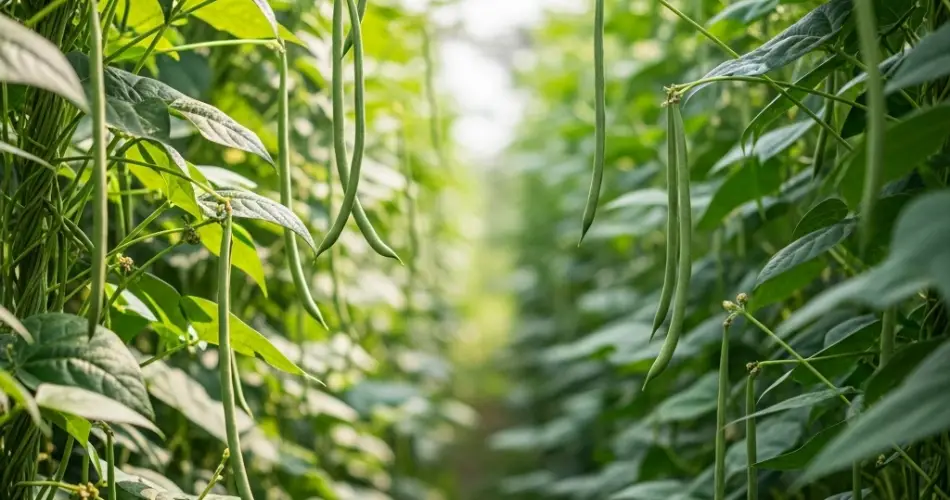String beans, also known as green beans or snap beans, are a popular garden vegetable valued for their crisp texture, mild flavor, and high yield. Whether you’re growing bush beans or pole beans, understanding their water and sunlight requirements is crucial to a healthy, productive harvest. These two elements—sunlight and moisture—directly affect germination, flowering, pod formation, and disease resistance.
Here’s a detailed look at how to properly water string beans and provide them with the sunlight they need to thrive.
Sunlight Requirements for String Beans
1. Full Sun is Essential
String beans grow best in full sun, meaning they need at least 6 to 8 hours of direct sunlight daily. Sunlight fuels photosynthesis, which drives healthy leaf growth, flower production, and ultimately, the development of bean pods. Insufficient sunlight can result in leggy plants, delayed flowering, and reduced yields.
If you’re growing string beans in containers or a garden with partial shade, try to position them in the sunniest location possible. South-facing areas are ideal in most climates. Avoid placing them behind taller plants or near walls that might cast shade during peak daylight hours.
2. Morning Sun is Better than Afternoon Shade
While string beans need full sun, morning sunlight is particularly beneficial, especially in hotter climates. Morning sun helps dry off dew and moisture from leaves, reducing the risk of fungal infections. Afternoon shade can be tolerable in very hot regions, but make sure the plants still receive a minimum of six hours of good light.
3. Indoor Starts Need Supplemental Light
If you’re starting beans indoors, be aware that window light is usually not strong enough. Use grow lights to supplement until the plants are ready to be transplanted outdoors. Without adequate light from the beginning, seedlings can become weak and stretched.
Watering Requirements for String Beans
1. Water Consistently but Avoid Overwatering
String beans need consistent moisture, especially during flowering and pod development. However, they do not tolerate soggy soil. Overwatering can lead to root rot, fungal diseases, and poor aeration.
Aim to keep the soil evenly moist, not waterlogged. This usually means watering once or twice a week, depending on your climate, soil type, and rainfall. In hotter, drier weather, your beans may need more frequent watering.
2. Deep Watering Encourages Strong Roots
Rather than frequent light watering, give your beans a deep watering to encourage roots to grow deeper into the soil. Shallow watering only moistens the top layer, which can result in weak, shallow root systems. Use a slow trickle or drip irrigation to allow water to soak 6–8 inches deep.
3. Morning is the Best Time to Water
Watering in the early morning is ideal. It gives the plants time to absorb moisture before the heat of the day and allows excess water on leaves to evaporate, reducing the chances of fungal diseases like powdery mildew or rust.
Avoid watering in the evening, as this keeps the leaves wet overnight and promotes disease development.
4. Mulch to Conserve Moisture
Applying a layer of mulch—such as straw, grass clippings, or compost—helps retain soil moisture, regulate temperature, and prevent weeds from competing for water. This is especially useful during hot weather when evaporation is rapid.
5. Watch for Signs of Over or Underwatering
-
Signs of underwatering include drooping leaves, slow growth, and dry, cracked soil.
-
Signs of overwatering include yellowing leaves, soft stems, and the appearance of mold or mildew near the base of the plant.
Adjust your watering schedule based on weather conditions and how the plants respond. Clay soils hold water longer than sandy soils, so soil type also matters.
Special Considerations by Growth Stage
-
Germination Stage: Keep the soil consistently moist until seedlings emerge. Don’t let the topsoil dry out during this period.
-
Vegetative Growth: Maintain even watering, focusing on encouraging strong foliage and root development.
-
Flowering and Pod Development: Increase watering slightly during flowering and early pod formation, as moisture stress can cause flowers to drop and result in poor yields.
-
Mature Pod Stage: Reduce watering slightly as pods near maturity to prevent splitting and reduce the risk of disease before harvest.
Container-Grown Beans
If you’re growing string beans in pots or containers, they may need more frequent watering than those in the ground. Containers dry out faster, especially in full sun. Check daily, and water whenever the top inch of soil feels dry.
Make sure containers have good drainage holes to prevent water from sitting at the bottom, which can lead to root rot.
Conclusion
Providing the right balance of sunlight and water is essential for growing healthy, productive string beans. Aim for full sun exposure (6–8 hours a day) and maintain consistent but not excessive moisture levels. By monitoring your plants and adjusting care based on the season and growth stage, you’ll enjoy a robust harvest of crisp, flavorful beans from your garden.



